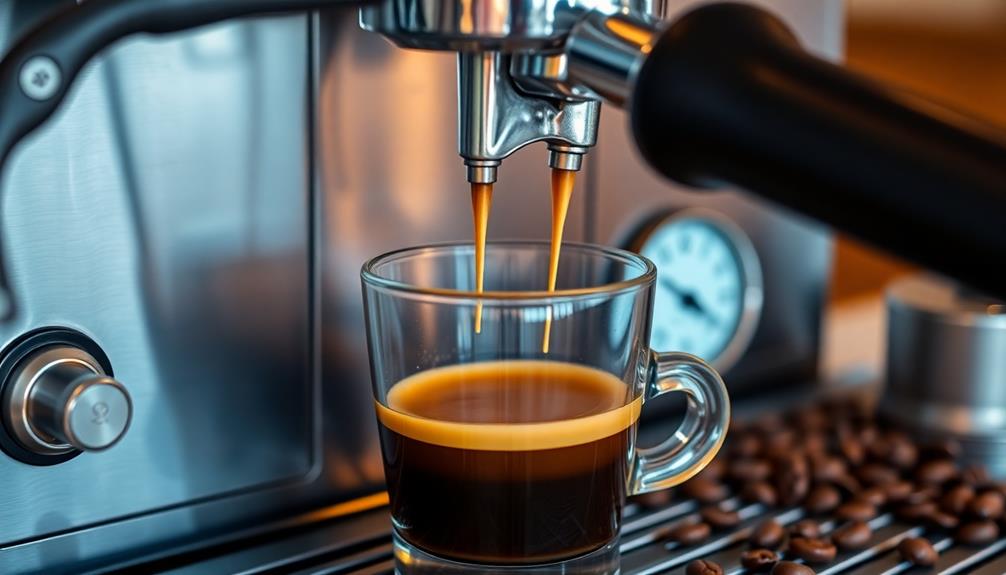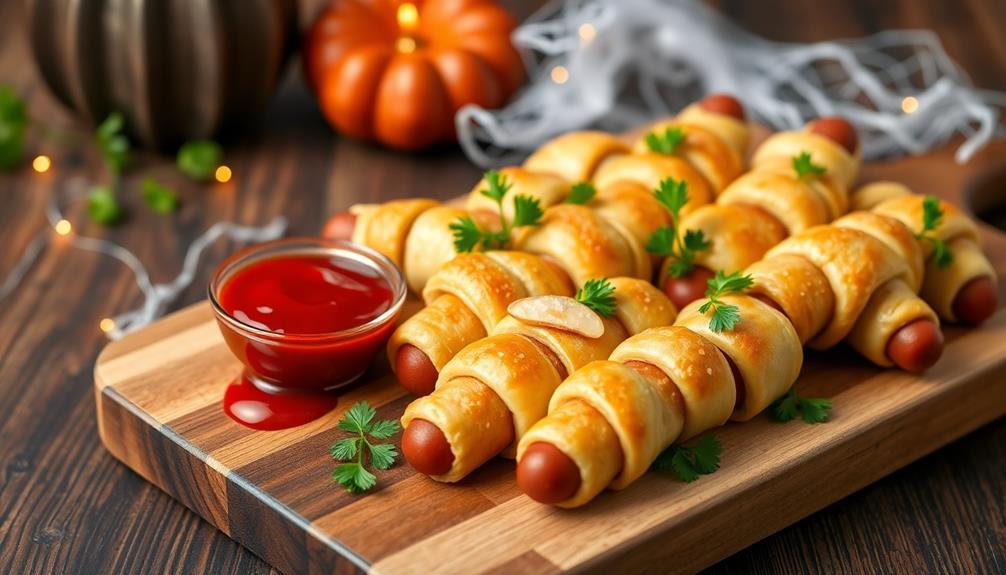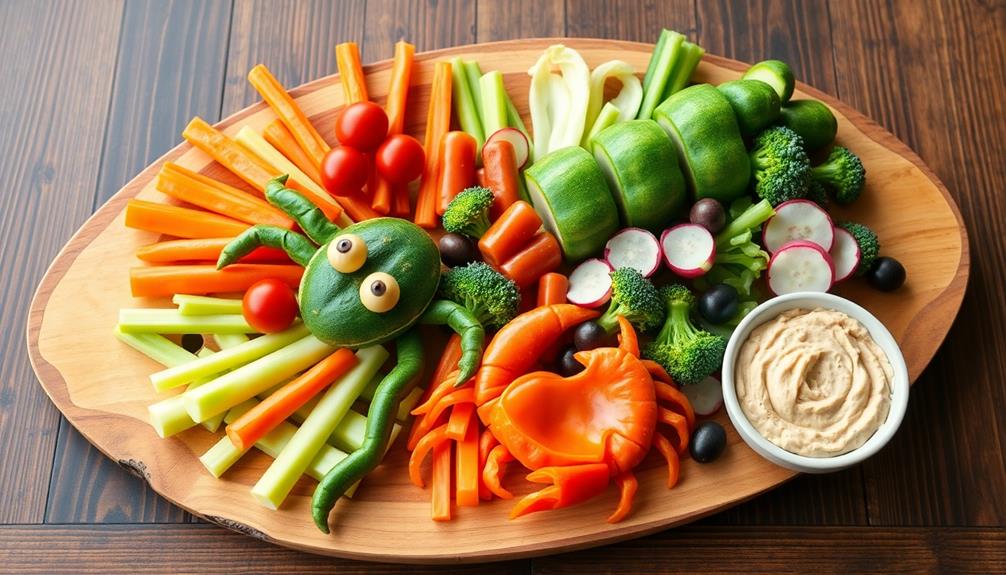The science behind perfect espresso extraction involves careful control of variables like grind size, water temperature, and pressure. You'll want to start with freshly roasted beans, ideally Arabica, for the best flavor. Your grind should be very fine, allowing water to flow through at 195°F to 205°F with consistent pressure around 9 bars. Aim for an extraction time of 20 to 30 seconds to develop a rich crema and balance flavors. Minor adjustments can greatly impact your espresso's taste. If you're curious about how these elements interact for an exceptional shot, there's much more to explore.
Key Takeaways
- Perfect espresso requires balanced flavors and aromas, typically extracted in 20 to 30 seconds for optimal taste development.
- Fresh, darkly roasted Arabica beans are ideal, used within two to four weeks post-roasting for maximum flavor and aroma.
- A very fine grind size (100 to 200 micrometers) is essential for proper extraction, ensuring uniformity with a burr grinder.
- Ideal brewing conditions include water temperature between 195°F to 205°F and consistent pressure of approximately 9 bars for rich texture.
- Consistency in extraction yield (17% to 23%) is crucial, as minor adjustments can significantly affect the final flavor profile.
Definition of Perfect Espresso
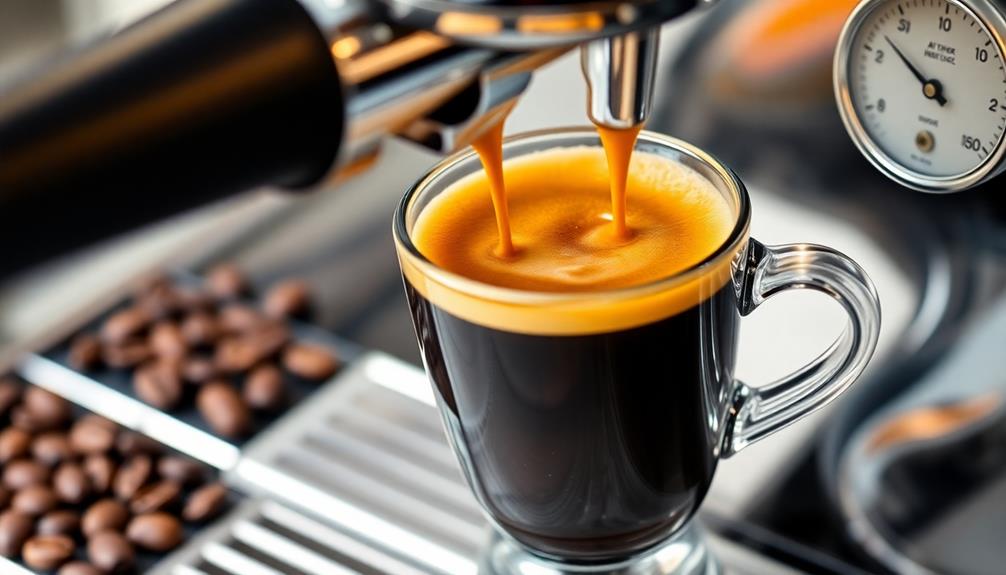
When you think about perfect espresso, imagine a shot that hits all the right notes—balanced flavors, a rich texture, and a delightful aftertaste. A perfect espresso shot is distinctively different from average ones, showcasing the beauty of precision in espresso brewing. Achieving this ideal requires careful control of various variables, including water temperature, pressure, and extraction time.
Understanding the artistry behind culinary traditions from around the world can also enhance your appreciation for the nuances in flavor.
The extraction time plays a vital role, ideally falling between 20 to 30 seconds. This timeframe allows the coffee to develop its full flavor profile, enhancing its richness and complexity. A well-extracted espresso should also feature a creamy layer on top known as crema. This golden froth not only indicates quality and freshness but also contributes to the overall experience of sipping your espresso.
To create perfect espresso, you need to focus on the balance of flavors and aromas. Each element must harmonize to guarantee that every sip delights your palate.
Whether you're a seasoned barista or just starting your espresso journey, understanding these fundamentals will help you consistently brew the perfect espresso shot.
Selection of Coffee Beans
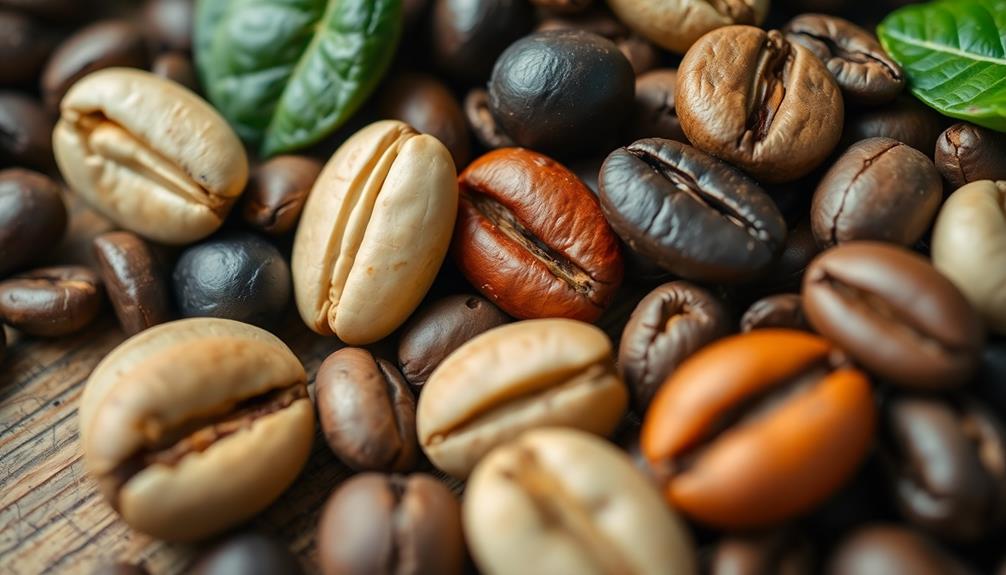
When selecting coffee beans for espresso, the roast level plays an essential role in shaping the flavor profile you'll experience.
For instance, a darker roast may provide a bolder taste, similar to the rich flavors found in Red-Braised Pork Belly.
You need to take into account the grind size and guarantee your beans are fresh to maximize taste and aroma.
Roast Level Impact
The roast level of your espresso beans plays an essential role in shaping the overall flavor profile. Depending on the roast, you can experience a wide range of taste sensations. For instance, darker roasts typically yield a stronger, more bitter flavor, while lighter roasts retain higher acidity and fruity notes. When using Arabica beans, you often find that medium or dark roasts create an ideal flavor balance, combining natural sweetness with complexity.
Here's a quick comparison:
| Roast Level | Flavor Characteristics |
|---|---|
| Light Roast | Fruity, floral, high acidity |
| Medium Roast | Balanced, sweet, mild acidity |
| Medium-Dark Roast | Rich, chocolatey, slight bitterness |
| Dark Roast | Bold, bitter, low acidity |
| Espresso Roast | Full-bodied, intense, caramelly |
The choice of roast level also impacts the extraction process. Lighter roasts may need adjustments in brew time and grind size to achieve that desired ideal flavor balance. Regardless of roast level, using freshly roasted beans is vital, as they lose aromatic compounds shortly after roasting. Freshness is key to your perfect espresso!
Grind Size Importance
Understanding grind size is imperative for brewing the perfect espresso. The ideal grind size for espresso should be very fine, typically between 100 to 200 micrometers. This fine grind maximizes the surface area, allowing for efficient extraction of flavors and aromas.
When you use a finer grind, you increase water resistance, which slows the flow and permits a longer extraction time. This longer extraction enhances the overall flavor profile of your espresso. Additionally, just as with the meticulous preparation of traditional dishes like agnolotti, achieving the right balance in your espresso grind can greatly elevate the final experience.
Consistency in grind size is essential. If your grind isn't uniform, you'll end up with uneven extraction—some grounds will be over-extracted, yielding a bitter taste, while others will be under-extracted, resulting in a weak flavor.
Adjusting the grind size helps you achieve the desired flavor balance; coarser grinds can fix over-extraction issues, while finer grinds can address under-extraction.
To achieve a uniform grind, opt for a burr grinder over a blade grinder. Burr grinders create a consistent grind size, which is important for ideal espresso quality.
Pay attention to your grind size, and you'll reveal the full potential of your espresso, delivering a delicious cup every time.
Freshness of Beans
Achieving the perfect espresso goes beyond grind size; the freshness of your coffee beans plays an essential role in the overall quality. Freshness is important because stale beans lose aromatic compounds, leading to a diminished flavor profile in your espresso.
Ideally, you should use beans within two to four weeks of roasting to guarantee you're getting the best flavor and aroma. Additionally, just as the vibrant flavors of Brazilian cuisine, like Caruru, can be influenced by the freshness of ingredients, so too can your espresso benefit from freshly roasted beans.
When selecting your beans, remember that darkly roasted varieties are often preferred for espresso due to their stronger, more bitter flavors. However, even these beans need to be fresh for you to achieve a balanced cup.
If you want to maximize the taste experience, focus on how you store your beans. Proper coffee storage in an airtight container, kept in a dark and dry place, is crucial to preserving the freshness of coffee beans and preventing oxidation.
Ultimately, the aromatic intensity and flavor of your espresso are directly tied to the freshness of your beans. By prioritizing this aspect, you're setting yourself up for a truly exceptional espresso experience.
Variables in Espresso Extraction
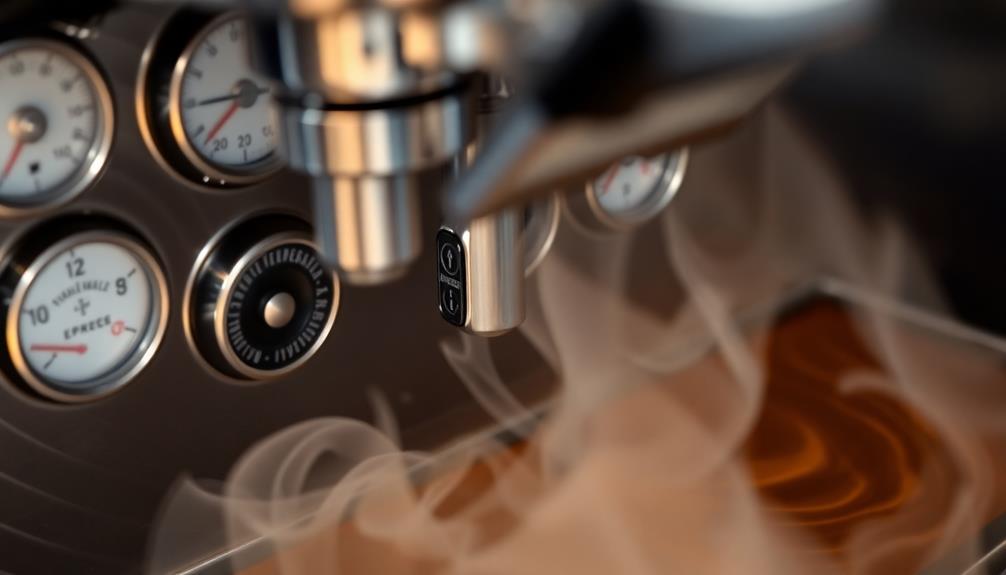
When brewing the perfect espresso, several key variables come into play that can make or break your shot. Understanding these factors helps you refine your process for a rich, concentrated flavor.
For instance, just as the quality of ingredients impacts dishes like Nettle and Potato Soup, sourcing fresh coffee beans can enhance your espresso's flavor profile.
Here are the main variables you need to take into account:
- Pressure: Aim for around 9 bars to efficiently extract flavor from your coffee grounds.
- Grind: A fine grind maximizes surface area, but inconsistent particle sizes can lead to uneven extraction.
- Water Temperature: Keep it between 195°F and 205°F. Too hot or too cold can result in sour or bitter flavors.
- Extraction Time: Ideally, your extraction should last between 20 to 30 seconds. Shorter times yield weak espresso, while longer times create harsh notes.
Water Temperature and Pressure
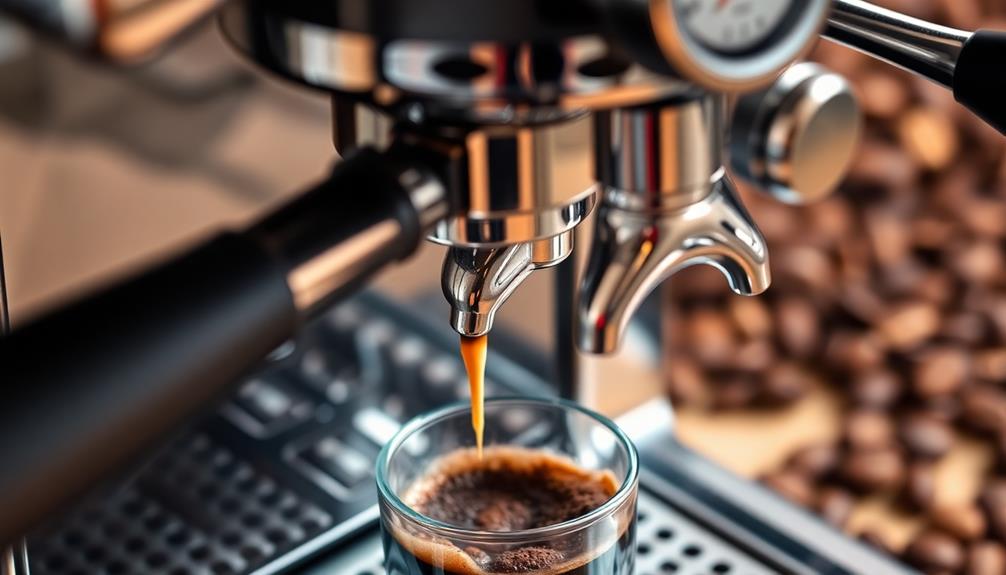
When brewing espresso, you need to pay close attention to water temperature and pressure.
The ideal temperature range of 195°F to 205°F guarantees you extract the best flavors without bitterness, while maintaining a consistent pressure of 9 bars is key for that rich, creamy texture.
Additionally, just like the precise techniques involved in creating Horiatiko Psomi (Country Bread), getting these variables right will greatly enhance your espresso experience.
Ideal Temperature Range
To brew the perfect espresso, you need to pay close attention to both water temperature and pressure. The ideal water temperature for espresso extraction ranges from 195°F to 205°F (90°C to 96°C). This range guarantees optimal solubility of coffee compounds, allowing for a rich flavor profile in your cup.
Just as achieving the right temperature is vital for espresso, the same attention to detail can elevate classic American dishes like a Loaded Baked Potato, where the perfect melt of cheese and butter enhances the experience.
When you use high-quality espresso machines, you often benefit from advanced temperature control systems. Maintaining consistency is key to achieving perfect espresso shots.
Remember, if the water temperature is too low, you risk under-extraction, resulting in sour, weak flavors. Conversely, if it's too high, you'll over-extract, leading to bitter and harsh tastes.
Here are some essential points to reflect on:
- Ideal temperature range: 195°F to 205°F (90°C to 96°C)
- Under-extraction risks: Low temperatures can create sour flavors
- Over-extraction risks: High temperatures can yield bitterness
- Importance of consistency: High-quality machines help maintain perfect conditions
Balancing water temperature with pressure directly influences the efficiency of extraction and your espresso's overall flavor profile.
Pressure Impact on Extraction
Achieving the perfect espresso isn't just about temperature; pressure plays an essential role in the extraction process. When brewing, water needs to be forced through coffee grounds at a pressure of around 9 bars. This pressure is crucial for developing that rich, creamy texture you're after. If you're not managing pressure well, you risk either under-extraction or over-extraction, both of which can ruin your espresso.
Here's a quick overview of how pressure and temperature interact during extraction:
| Pressure (Bars) | Extraction Quality | Resulting Texture |
|---|---|---|
| 7-8 | Under-extraction | Thin and watery |
| 9 | ideal extraction | Rich and creamy |
| 10-11 | Over-extraction | Bitter and harsh |
| <7 | Inconsistent | Variable texture |
| >11 | Excessive | Unpleasant bitterness |
Maintaining consistency in both pressure and temperature (195°F to 205°F) is key. If your grind size is too fine, it can create resistance, causing excessive pressure and leading to over-extraction. Focus on these factors to guarantee a balanced flavor profile and that beautiful crema on top of your espresso.
Extraction Time and Crema Formation
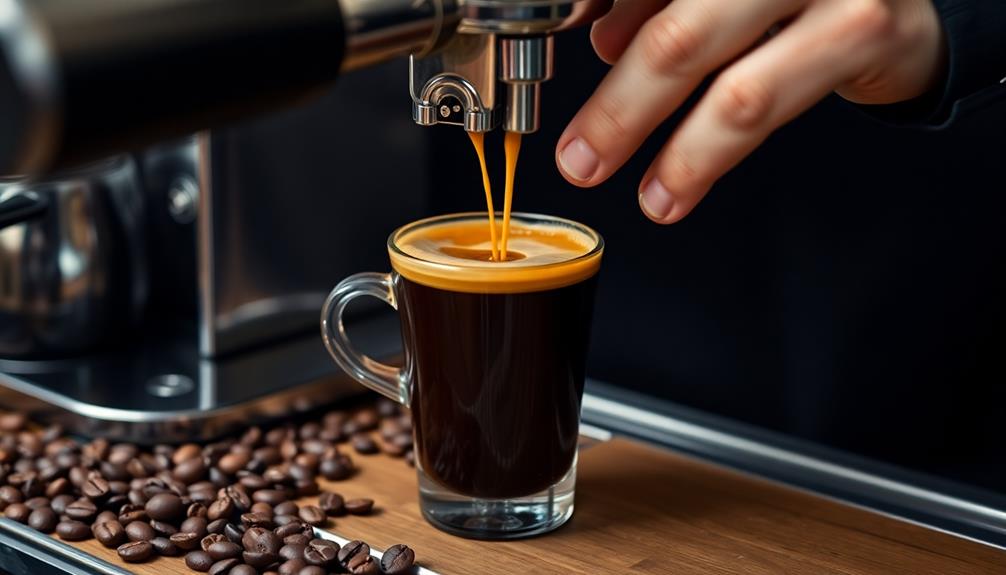
Timing plays an important role in achieving the perfect espresso extraction, with the ideal range being 20 to 30 seconds. If you extract too quickly, you risk under-extraction, resulting in a sour taste. Conversely, if you go too long, over-extraction can lead to bitterness.
To guarantee you stay within this ideal range, consistent use of a timer is key. Just like the careful balance of flavors in a dish like Hiyashi Chuka, precision in timing is vital for achieving the desired outcome.
Crema, that frothy layer on top of your espresso, is a sign of quality. It forms from the emulsification of oils and proteins during brewing, and its presence enhances both the visual appeal and flavor profile of your shot.
Here are some factors influencing crema formation:
- Freshness of the coffee beans
- Roast level of the beans
- Water temperature during extraction
- Water pressure applied during brewing
A well-formed crema not only signifies a well-extracted shot but also contributes to a balanced flavor experience. By paying attention to extraction time and the factors that influence crema, you'll elevate your espresso-making skills and enjoy a richer, more satisfying cup.
Techniques for Consistent Preparation
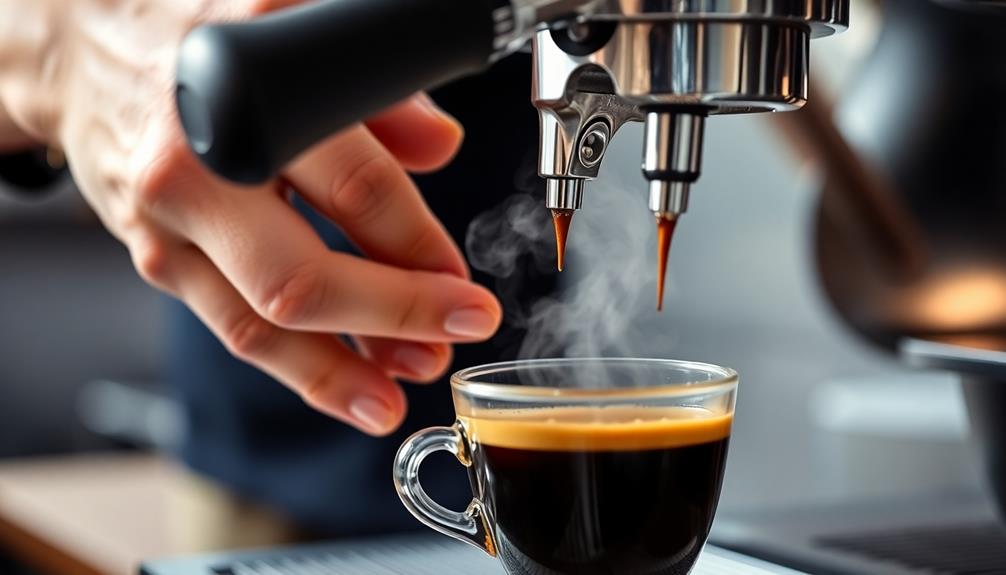
To achieve consistent espresso preparation, you need to focus on grind size adjustment and extraction time control.
Start by using a burr grinder to guarantee your coffee grounds are uniform, which is critical for even extraction. This precision is similar to how the rich blend of spices enhances the earthy mushroom flavor in Mushroom Masala.
Then, keep a close eye on your extraction time, as even slight variations can drastically affect the flavor profile of your espresso.
Grind Size Adjustment
When it comes to crafting the perfect espresso, understanding grind size adjustment is essential for consistent preparation. The grind size directly affects extraction and the overall flavors in your cup.
Ideally, you should aim for a fine grind, typically between 100 to 200 micrometers. In a similar way to how Kue Putu relies on precise ingredients for its unique flavor, your espresso requires careful attention to grind size.
Here are some techniques to help you achieve a uniform grind:
- Use a burr grinder: It creates a more consistent grind size compared to a blade grinder, ensuring even extraction.
- Adjust incrementally: Make small adjustments to your grind size to find the sweet spot; too coarse can lead to sourness, while too fine may cause bitterness.
- Test regularly: Different coffee beans and roast levels require different grind sizes; darker roasts may need a slightly coarser grind to balance flavors.
- Maintain consistency: Uneven coffee grounds disrupt water flow, leading to over-extraction of some and under-extraction of others, negatively impacting your espresso shot.
Extraction Time Control
Achieving the perfect espresso involves mastering extraction time control, with the ideal range being 25 to 30 seconds. This precise extraction time is essential for developing a balanced flavor profile.
If you brew for less than 25 seconds, you risk under-extraction, leading to sour flavors that ruin your shot. On the other hand, brewing beyond 30 seconds can result in over-extraction, introducing bitterness that masks the coffee's natural sweetness.
To maintain consistency, use a timer while brewing. This allows you to monitor extraction time closely and adjust as needed.
Keep in mind that grind size plays a significant role in your extraction. Finer grinds may require shorter extraction times to avoid that unpleasant bitterness, while coarser grinds can handle a bit longer without sacrificing flavor.
Regularly test and taste your espresso shots at different extraction times. This practice will help you refine your technique and develop a keen sense of what works best for your preferred beans.
Challenges in Consistency and Yield
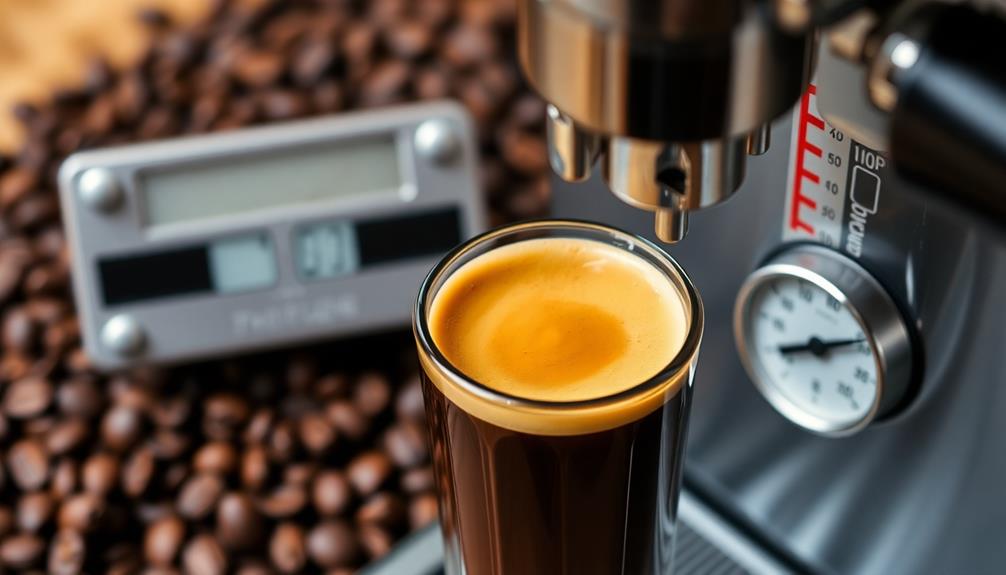
Consistent espresso extraction can be a tricky endeavor, and even minor fluctuations in brewing variables can lead to considerable differences in flavor.
It's vital to understand how extraction yield and other factors affect your espresso. Here are some challenges you might face:
- Extraction Yield: The Specialty Coffee Association recommends an extraction yield between 17% and 23% for ideal flavor. Straying from this range can drastically alter taste.
- Grind Size: Adjusting grind size can greatly affect extraction yield. A finer grind tends to increase extraction, while a coarser grind may decrease it, impacting flavor compounds.
- Brewing Variables: Temperature, pressure, and time all play important roles in achieving consistency. Variability in any of these can lead to inconsistent shots.
- Subjectivity in Tasting: Espresso competitions highlight how differently judges can score shots due to variability, emphasizing the subjective nature of espresso tasting.
Economic Implications of Espresso
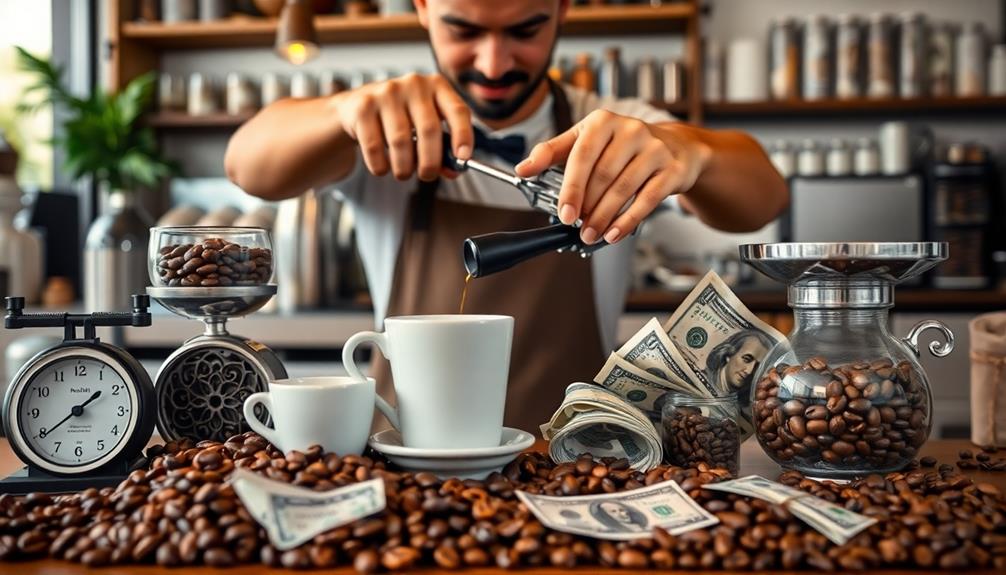
Understanding the challenges in achieving consistent espresso extraction not only affects flavor but also has significant economic implications for coffee businesses. By optimizing extraction methods, you can drastically reduce operational costs. For instance, research by Chris Hendon reveals that cafes could cut coffee usage by 25%, which translates to substantial savings across the industry.
One of the most striking statistics is that the US coffee industry serves about 124 million espresso-based beverages daily. If coffee shops implement faster shot times—from 25 seconds to just 14 seconds—they can enhance efficiency and profitability. Hendon's model aims for a 23% yield, potentially saving the US coffee industry around $1.1 billion annually.
Here's a quick overview of the economic impact:
| Factor | Current Scenario | Optimized Potential |
|---|---|---|
| Coffee Usage | 124 million beverages daily | 25% reduction possible |
| Operational Costs | High due to coffee waste | Significant savings |
| Extraction Time | 25 seconds per shot | 14 seconds per shot |
| Annual Savings | — | $1.1 billion |
Focusing on quality espresso can also shape market dynamics, attracting consumers who value flavor while ensuring financial sustainability.
Barista Experience and Artistry
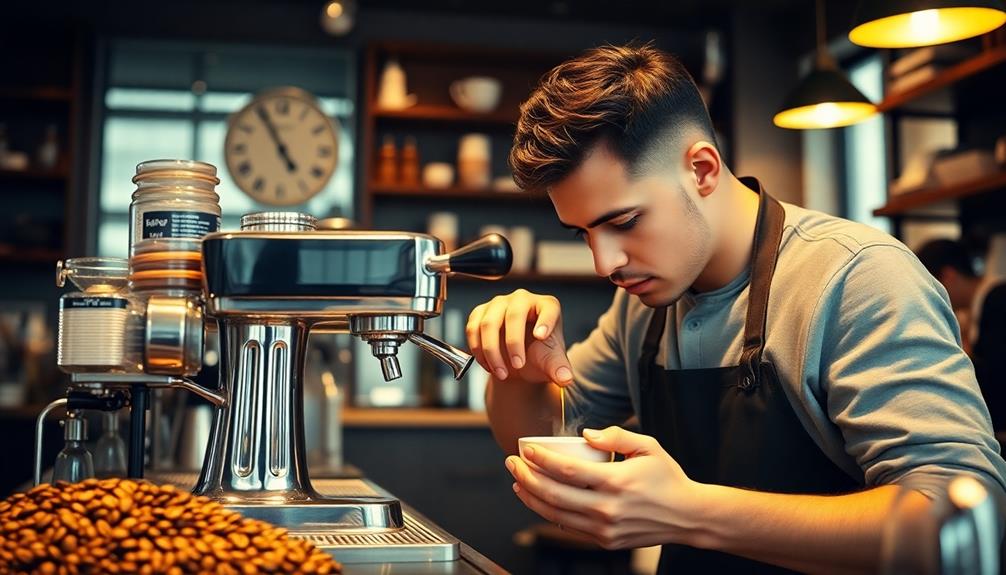
A skilled barista can make all the difference when it comes to crafting high-quality espresso. Their experience allows them to expertly manipulate key variables, guaranteeing that each shot reveals the coffee's unique flavor profile.
By understanding how grind size and extraction time affect taste, you can appreciate the artistry that goes into every cup.
Consider these essential aspects of barista expertise:
- Grind Size: The right texture influences extraction and flavor.
- Extraction Time: Precision in timing guarantees balanced flavors.
- Flavor Nuances: Knowledge of bean origins helps highlight distinct characteristics.
- Community Knowledge-Sharing: Collaboration enhances skills and fosters growth.
Engaging with fellow baristas and participating in knowledge-sharing opportunities not only refines techniques but also enriches your understanding of coffee's complexities.
Furthermore, the emotional connection between baristas and customers adds to the overall experience. When baristas are passionate and happy, it translates to a more enjoyable atmosphere in cafés, making each espresso moment memorable.
Ultimately, a skilled barista's blend of technical ability and emotional connection elevates the craft of espresso making, creating a perfect cup every time.
Innovations in Coffee Sourcing and Grinding
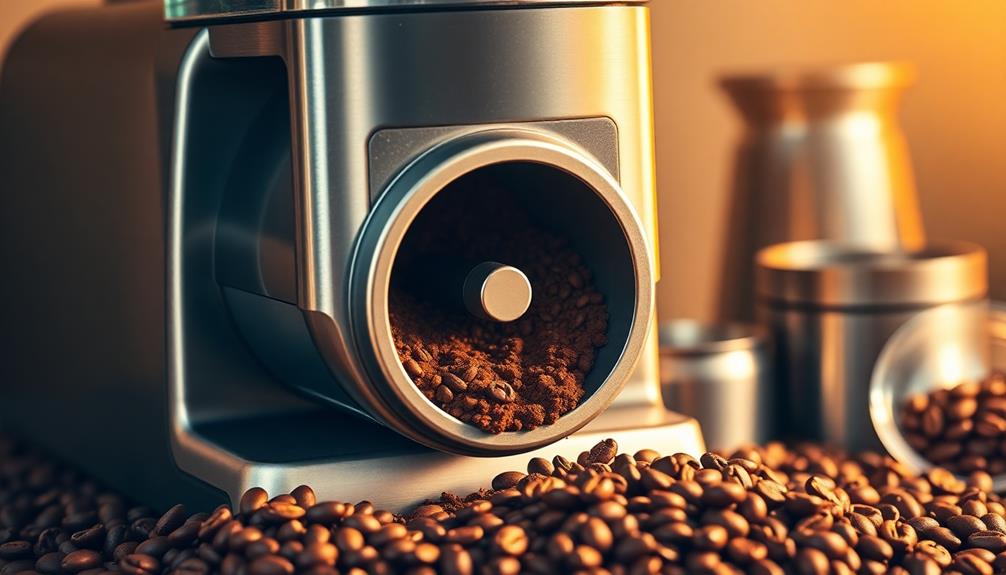
The journey to perfect espresso doesn't stop at the barista's skills; it extends into the domain of coffee sourcing and grinding innovations.
Today, sustainable practices in coffee sourcing guarantee that beans are ethically acquired while maintaining exceptional quality. Direct trade models not only benefit farmers but also enhance transparency in the supply chain.
On the grinding side, advanced techniques have become vital. Burr grinders, for instance, provide a uniform grind size essential for effective extraction and rich flavors. Some modern grinders even allow you to make precise adjustments, enabling you to fine-tune your espresso for ideal results.
Additionally, exploring different coffee varieties and processing methods can dramatically alter flavor profiles, injecting complexity into your espresso.
Innovations also focus on minimizing heat generation during grinding, which helps preserve volatile aromatic compounds in coffee beans. This results in a fresher taste and overall better quality espresso.
Frequently Asked Questions
What Is the Science Behind Espresso Extraction?
Espresso extraction's all about precision. You need the right temperature, grind size, and timing. If you don't control these factors, your espresso might taste sour or bitter, ruining the rich flavors coffee can offer.
What Does the Perfect Espresso Extraction Depend On?
You might think espresso is all about the machine, but it actually depends on precise water temperature, pressure, grind size, and timing. Master these factors, and you'll achieve a rich, balanced shot every time.
How Is the Perfect Espresso Made?
To make the perfect espresso, you'll want to use finely ground coffee, measure 7 to 9 grams per 2 ounces of water, and control water temperature, pressure, and extraction time for ideal flavor.
How Do You Extract Good Espresso?
To extract good espresso, think of a painter blending colors. You grind your beans finely, heat water just right, and control the pressure. Experiment with time, tasting until you find that perfect, harmonious balance.
Conclusion
In crafting the perfect espresso, you're not just brewing coffee; you're marrying science with art. By selecting the right beans, controlling water temperature, and mastering extraction time, you reveal rich flavors and creamy textures. You face challenges in consistency and yield, but with experience and innovation, you can elevate your craft. So, embrace the process, experiment with techniques, and enjoy the journey to that perfect cup. After all, every shot is an opportunity to refine your skills and delight your senses.
